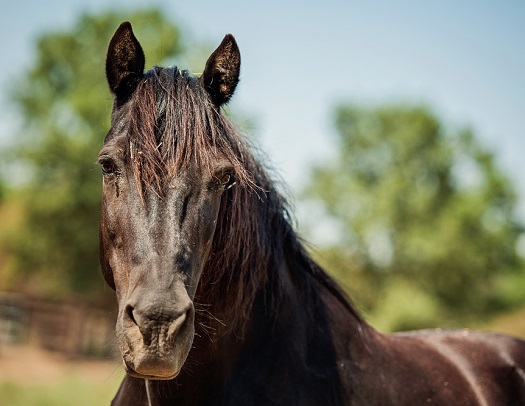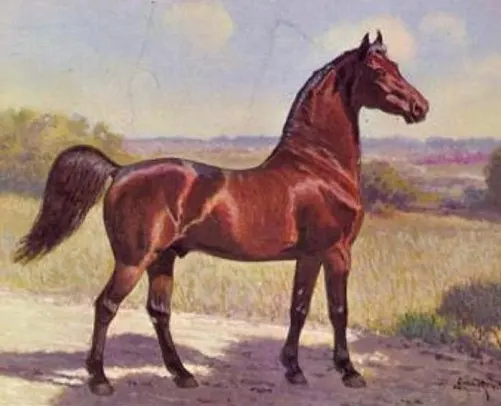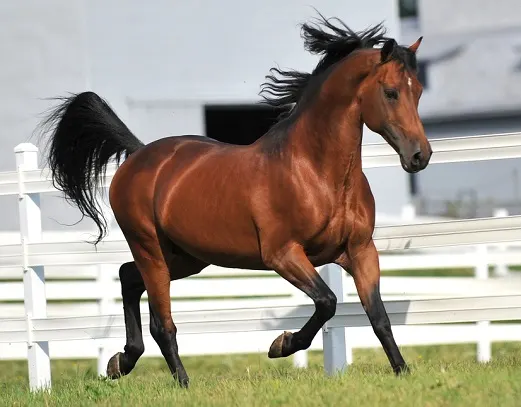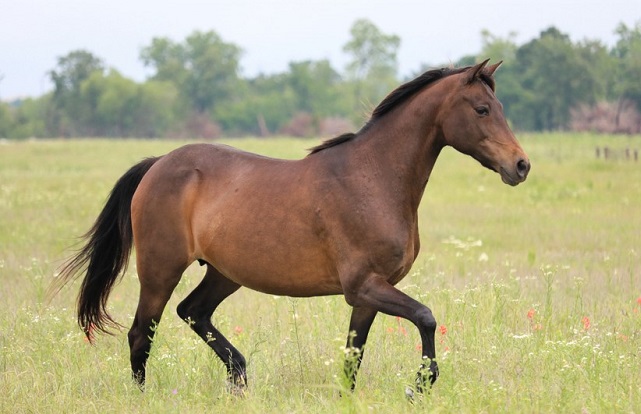The Morgan horse is one of the earliest American horse breeds that still exist today. They are easy to recognize from their prominent eyes, arched necks, and graceful movement that captivates horse lovers around the world.
Morgan horses are famous for their people-loving attitude, intelligence, and gentle nature. They have outstanding stamina and are extremely versatile, performing well in both English and Western disciplines.
Morgans are a popular choice for equine therapy, driving, and stock purposes.
A typical Morgan stands between 14.1 and 15.2 hands at the withers, but some are outside this range. The most common colors in the breed are black, bay and chestnut, but many others are acceptable, including pinto.
Here are eleven facts about Morgan horses.
Morgan Horses Are One of the First Horse Breeds Developed in the Us
The Morgan horse is, in fact, the second native American horse breed. The first breed to develop in the United States was the now-extinct Narragansett Pacer. However, no existing American horse breed can trace its ancestry as far back as the Morgan horse.
The Morgan breed was an indispensable asset to Americans in the 19th century. Other than general riding, they worked as coach horses, partook in harness races, and were the go-to cavalry mounts in the American Civil War. Between 1906 and 1951, the US Department of Agriculture bred Morgan horses specifically for war.

Horse Crazy / Shutterstock.com
The Morgan Horse Club, later called the American Morgan Horse Association (AMHA), was established in 1909.
Prior to 1909, only horses deemed by Colonel Joseph Battell to be the descendants of Figure were regarded as Morgan horses (Source: AMHA).
Many other breed registries followed in the next few decades, spread across the United States, Europe, and Oceania.
“The Horse That Chooses You”
Due to their remarkable ability to connect with people, the AMHA dubbed the Morgan horse “The Horse That Chooses You.” This phrase also serves as the registry’s slogan, and many enthusiasts use it to refer to the breed.
The Founding Sire of the Morgan Breed Is Figure
All Morgan horses today descend from one foundation sire called Figure. Figure was a stallion of unknown origins born in 1789 and given to Justin Morgan as debt payment. Recognizing the stallion’s unique ability to pass on his best traits, Justin Morgan used Figure to create a new breed.
While his pedigree is not known, it is thought that Figure’s sire was a Thoroughbred stallion called True Briton. Moreover, his dam was likely a mare of Arabian and Barb breeding, according to the AMHA.

Figure
Figure was believed to be 14 hands tall, lightly built, and weighed around 1,000 pounds (450 kg).
His owner, Justin Morgan, was a man of many professions. Born in 1747, he was a musician, horse breeder, and tavern keeper, among other things. Following his success with Figure, the stallion was named after him, and “Morgan” became the name of the new breed.
Interestingly, Figure only sired six known sons throughout his career as a stud. Three of his offspring went on to become prominent foundation stallions in the breed, namely Sherman, Bulrush, and Woodbury.
One of his sons, called Black Hawk, became a foundation sire for the American Saddlebred, Standardbred, and Tennesse Walking Horse breeds.
Also Read: 8 Facts About Tennessee Walking Horses.
There Are Four Main Bloodlines Within the Morgan Breed
The four primary bloodlines in the Morgan breed are the Brunk, Lippitt, Government, and Western Working “families.”
These bloodlines originate from breeding programs conducted in the 1800s and 1900s. Each of these families has slightly different traits, depending on which breeding program they descend from.
The Brunk family was started by horse breeder Joseph Brunk in Illinois. Horses from this family are renowned for their athleticism and soundness. They are well-muscled and slightly heavier built than their distant cousins.
The Lippitt breeding program was named after Robert Lippitt Knight, who maintained a high level of purity in his horses. Lippitt Morgans had no outside influence in the last century, and most bloodlines trace directly back to Figure.
Lippitt Morgans are the rarest of the four bloodlines, with less than 1,000 horses in existence (Source).

Christopher Crosby Morris / Shutterstock.com
The horses of the Government family descend from the cavalry mounts bred by the USDA. In 1951, the University of Vermont took over the breeding program, purchasing most of the breeding stock. Morgans from this family are by far the most abundant in numbers.
The Western Working family is a collective category for Morgans that descend from working and stock horses. Many of these horses trace their ancestry to stallions from the Government family that were shipped to western states.
There Are Nearly 90,000 Registered Morgans Worldwide
According to the AMHA, there were around 89,000 registered Morgans in the world in 2015. As for the number of Morgan horses that exist worldwide, the grand total is estimated to be between 175,000 and 180,000.
While the breed is most popular in the United States, larger Morgan populations exist in Sweden and the United Kingdom.
By 2012, the AMHA has registered approximately 179,000 horses over its lifetime. Moreover, according to the United States Equestrian Federation, over 3,000 foals are registered with the association each year.
Morgans Have Influenced Many American Horse Breeds
Since Morgans were among the first horse breeds developed in the United States, it’s not surprising that they influenced many other American horse breeds. A few examples are the American Quarter Horse, Saddlebred, Standardbred, and the Tennessee Walking Horse.
In the 19th ad 20th centuries, the Morgan breed made its way around the world, further extending its influence. In England, for example, a Morgan stallion contributed to the developing Hackney horse.

Lisa Kolbenschlag / Shutterstock.com The Morgan Horse Is a National Pride
When it comes to the Morgan horse, there is much to be proud of. These fine little horses are not only intelligent, but have proven their worth against larger and stronger horse breeds.
Today, the Morgan horse is the state animal of not one, but two American states. In 1961, Vermont pronounced the Morgan their state animal, and Massachusetts did the same in 1970.
The Morgan Horse Appears in Literature and Film
The Morgan breed featured in the works of several children’s authors, including Ellen Feld and Marguerite Henry.
Two books of Feld’s “Morgan Horse” series received awards from the Children’s Book Council and the International Reading Association.
What’s more, Marguerite Henry’s “Justin Morgan Had a Horse” became a Newbery Honor Book in 1946. Even more exciting, the book was turned into a Disney movie in 1972.
Although Henry’s story didn’t always stay true to historical facts and was misleading in certain aspects, critics say.
Morgan Horses Are Easy Keepers and Have Long Lives
The average lifespan of a Morgan horse is 20 to 30 years. It’s not unusual that Morgans live well into their 30s, making them one of the longest-living horse breeds in the world. There are very few genetic diseases in the breed, which contributes greatly to their long and healthy lives.
Morgan Horses also keep well on a forage-only diet and require little to no grain. In fact, they are prone to becoming overweight if their diet is not monitored regularly.

Lisa Kolbenschlag / Shutterstock.com Some Morgan Horses Are Gaited
While the Morgan isn’t a gaited breed, some horses can perform special gaits such as the pace, fox trot, or rack. Their pacing ability originates in the 19th century when Morgan Horses were popular in harness racing.
Breeders developed both trotting and pacing Morgans for competition, hence why some horses can pace today.
Experts believe the gaited ability is not linked to any specific bloodlines and shows up spontaneously within the breed. It most likely originates from crosses with gaited horses early on in the Morgan’s development.
Also Read: What is a gaited horse?
Morgans Were the First to Represent the Us in the World Pairs Driving Competition
This horse breed really is full of surprises! The Morgan horse was the first American breed to earn a place in the World Pairs Driving competition, outperforming all other native breeds.
As it turns out, Morgan horses are just as talented in harness as under saddle. They often appear in driving competitions worldwide, bringing pride to the American nation.
Source: horseyhooves.com








